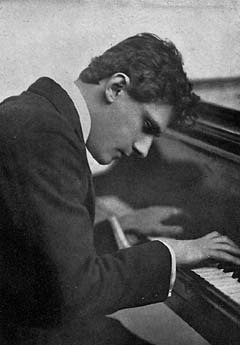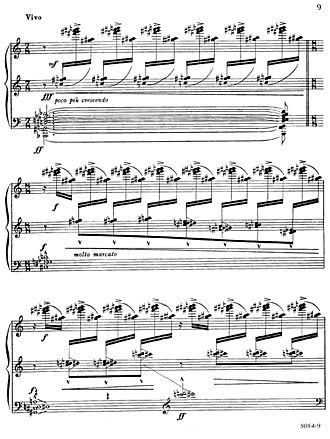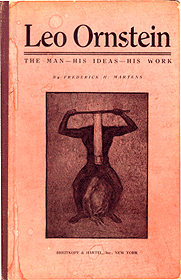Leo Ornstein facts for kids
Quick facts for kids
Leo Ornstein
|
|
|---|---|

Leo Ornstein as a young man, c. 1918
|
|
| Born | December 11, 1895 Kremenchug, Poltava Governorate, Russian Empire (now Ukraine)
|
| Died | February 24, 2002 (aged 106) Green Bay, Wisconsin, United States
|
| Occupation |
|
| Children |
|
| Signature | |
Leo Ornstein (born Лев Орнштейн, Lev Ornshteyn; c. December 11, 1895 – February 24, 2002) was an American experimental composer and pianist. He lived during the early 1900s. He was known for his very new and sometimes shocking music. His performances made him famous in both America and Europe. Most of his experimental pieces were written for the piano.
Ornstein was one of the first important composers to use "tone clusters" a lot. A tone cluster is when you play several notes right next to each other at the same time, often with your whole hand or arm. As a pianist, he was considered a world-class talent. But in the mid-1920s, he decided to leave his fame behind. He soon disappeared from public view. Even though he stopped performing publicly before he turned 40, he kept writing music for over 50 more years! After being mostly forgotten for decades, people rediscovered his music in the mid-1970s. Ornstein finished his eighth and last piano sonata in September 1990. He was 94 years old at the time. This made him the oldest published composer in history for a while.
| Top - 0-9 A B C D E F G H I J K L M N O P Q R S T U V W X Y Z |
Early Life and Musical Beginnings
Leo Ornstein was born in Kremenchug, which was part of the Russian Empire then. Today, it is in Ukraine. He grew up in a family that loved music. His father was a Jewish cantor, which is a singer who leads prayers in a synagogue. His uncle, who played the violin, encouraged Leo to study music.
Leo was recognized as a prodigy (a child with amazing talent) on the piano very early on. In 1902, when he was only six, a famous Polish pianist named Josef Hofmann heard him play. Hofmann was so impressed that he wrote a letter recommending Leo to the famous Saint Petersburg Conservatory. Soon after, Leo was accepted to the Imperial School of Music in Kiev.
In 1904, when he was nine, Leo was accepted into the St. Petersburg school. There, he studied how to compose music with Alexander Glazunov. He also learned piano from Anna Yesipova. By the age of eleven, Leo was earning money by coaching opera singers. To escape the pogroms (violent attacks against Jewish people) happening in Russia, his family moved to the United States. They arrived on February 24, 1906. This was exactly 96 years before Leo passed away.
The family settled in the Lower East Side of New York City. Leo enrolled in the Institute of Musical Art, which later became the famous Juilliard School. He studied piano there with Bertha Feiring Tapper. In 1911, he had his first public performance in New York. He played pieces by famous composers like Bach, Beethoven, and Chopin. People really liked his performance. Recordings from two years later show that he was a very sensitive and skilled pianist.
Becoming Famous for "Futurist" Music
Soon, Ornstein started to create a very different kind of music. He began writing pieces that had unusual and surprising sounds. These sounds were often "dissonant," meaning they didn't sound smooth or harmonious together. At first, even Ornstein himself was unsure about these new compositions. He wondered if he was losing his mind because the music was so unlike anything he had ever heard.
On March 27, 1914, in London, he performed these new works for the first time. People called this music "futurist" back then. Today, we call it modernist music. The concert caused a big stir! One newspaper said Ornstein's music was like a mix of other modern composers, but "squared" (meaning much more intense). Other people were not so kind, calling it "insufferable hideousness."
Ornstein's next performance caused a near-riot! He said, "I couldn't hear the piano myself. The crowd whistled and howled and even threw handy missiles on the stage." But not everyone disliked it. The Musical Standard newspaper called him "one of the most remarkable composers of the day." By the next year, he was the talk of the American music scene. He played cutting-edge works by other composers and his own even more radical pieces.
Between 1915 and the early 1920s, Ornstein was one of the most well-known (and sometimes controversial) figures in American classical music. People loved to hear him play. He often performed for huge crowds, sometimes more than two thousand people. His solo piano pieces, like Wild Men's Dance (also called Danse Sauvage; around 1913–14) and Impressions of the Thames (around 1913–14), were pioneers in using tone clusters in classical music. These are groups of notes played very close together. Another composer, Henry Cowell, helped make tone clusters even more popular later.
Wild Men's Dance is described as having "unruly rhythm" and "brutal accents." It uses huge, crashing chords across the whole piano. Even in 2002, a reviewer for The New York Times said it "remains a shocker." Impressions of the Thames used more unusual chords than other composers dared. It also had clusters of high notes and a low, pounding sound.
Ornstein also wrote a Sonata for Violin and Piano in 1915. He called this "abstract music" and felt it pushed music "to the very edge." He said, "beyond that lies complete chaos." In 1916, a critic named Herbert F. Peyser said that the music world had changed a lot between the time of Beethoven and Leo Ornstein.
People sometimes called Ornstein an "ultra-modernist." A newspaper called him "the intransigent pianist," meaning he was stubborn about his new style. They said he had "set the entire musical world by the ears." Another music magazine called him "the most salient musical phenomenon of our time." A Swiss-born composer, Ernest Bloch, even said Ornstein was "the single composer in America who displays positive signs of genius." By 1918, Ornstein was so famous that a full book was written about his life.
Even when he was known for his wild, modern music, Ornstein also wrote some beautiful, melodic pieces. One example is his First Sonata for Cello and Piano. He said he wrote it very quickly because he felt a strong urge to. He wondered why he would hear such a romantic piece in his head at the same time he was writing his "primitive" (wild) works. A critic later said this cello sonata had "gorgeous tunes" that could rival those by Rachmaninov.
A Change in the 1920s
By the early 1920s, Leo Ornstein was tired of performing so much. He mostly stopped his famous concert career. Because of this, his music was soon forgotten by many people. He became a less important figure in American music. He didn't seem to care much about being famous or not. He just listened to his own musical ideas.
Ornstein's main style of composing also began to change. He moved away from the very extreme, "futurist" sounds. This change made him fade even more into obscurity. The people who had been inspired by his radical music now rejected him. They were almost as upset as the critics he had shocked a decade earlier. Even Henry Cowell, who was usually very accepting, couldn't forgive Ornstein for changing his style.
Since he no longer performed concerts, Ornstein needed a new way to earn money. He signed a special contract with the Ampico company to make piano rolls. These were rolls of paper that could be put into a player piano to make it play music automatically. He made over two dozen rolls for Ampico. Most of them were of older, more traditional music by composers like Chopin, Schumann, and Liszt. Only two rolls had his own compositions. He never recorded any of his famous "futurist" pieces that had made him well-known.
In the mid-1920s, Ornstein left New York. He took a job teaching at the Philadelphia Musical Academy. During this time, he wrote some of his most important works. This included his Piano Concerto, which was asked for by the Philadelphia Orchestra in 1925. Two years later, he wrote his Piano Quintet. This was a long, melodic piece that also used interesting dissonant sounds and complex rhythms. It is now seen as a masterpiece.
Later Life and Rediscovery
In the early 1930s, Ornstein gave his very last public performance. A few years later, he and his wife, Pauline Cosio Mallet-Prèvost, started the Ornstein School of Music in Philadelphia. She was also a pianist. Famous jazz musicians like John Coltrane and Jimmy Smith were among their students. The Ornsteins ran and taught at the school until they retired in 1953.
After retiring, they mostly disappeared from public view. Then, in the mid-1970s, a music historian named Vivian Perlis found them. The couple was spending the winter in a trailer park in Texas. They also had a home in New Hampshire. Ornstein had continued to compose music all this time. He had a very strong memory, so he didn't always write everything down right away. He also hadn't tried to make his new music public for decades.
Even though his style had become much calmer since the 1910s, it still had its unique character. When he was rediscovered, it brought a new burst of creativity. In his eighties, Ornstein wrote piano pieces like Solitude and Rendezvous at the Lake. These pieces had melodies that were very unique and didn't sound like any other composer.
In 1988, when he was 92 years old, Ornstein wrote his Seventh Piano Sonata. This made him the oldest published composer to create a major new work for a few years. On September 23, 1990, at the age of 94, Ornstein finished his final work, the Eighth Piano Sonata.
Leo Ornstein passed away on February 24, 2002, in Green Bay, Wisconsin. He was 106 years old. He was one of the longest-living composers in history.
See also
 In Spanish: Leo Ornstein para niños
In Spanish: Leo Ornstein para niños
- List of solo piano compositions by Leo Ornstein



